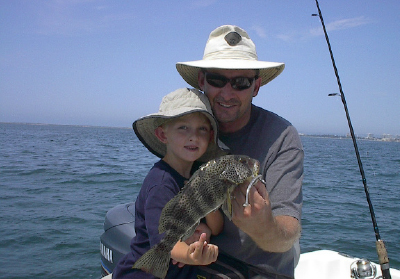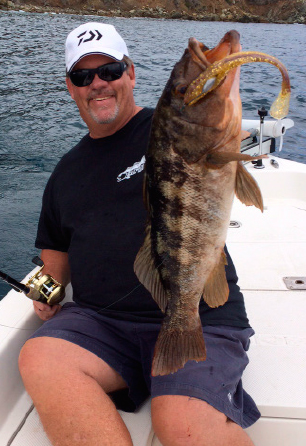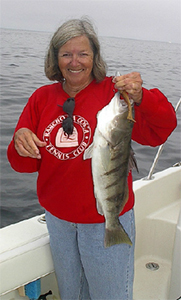
Spotted Bay bass are a great fish to start kids off fishing for.
I can still remember many of my first fishing experiences with my dad. He bought a boat when I was about 5 years old and off to San Diego bay we went chasing the saltwater bass a friend had told him about. My brothers and I learned to fish on those bass and it turned into a passion of mine and theirs. After 50 plus years, I now guide for them and fish competitively for them. They are one of my favorite and could be yours as well!
There are three inshore bass that southern California fishermen love to chase. They are the calico bass, which can reach a size of close to 15 pounds, and is probably the most favorite. The barred sand bass, which also can reach the ‘teens’ and are just as popular with fishermen. Finally, the spotted sand bass or spotted bay bass, cousin to the barred sand bass. The great thing about these fish are that they are available to fish for year round.
The spotted sand bass or spottys as they are affectionately called by the thousands of anglers who chase them, are the smallest of the three saltwater bass. But, don’t let this fool you, pound for pound they fight harder than most other game fish. They are built like their freshwater cousins, the smallmouth bass, and in many ways emulate their ways. Living in constantly moving tidal waters makes them muscular and strong.
The spottys live in the bays and backwaters from as far north as Santa Barbara to well south into Mexico, with the populations getting larger the further south you travel. San Diego Bay is one of the largest populated areas for these fish, with San Diego’s Mission Bay holding the IGFA record of 4.95 pounds. The California State record is 6 pounds 12 ounces and came from Newport Harbor.
Chasing these fish is a passion for many, and if fished on light to medium bass gear, they can be a challenging fish to hook and land. Most anglers use freshwater bass gear with 6 to 12 pound test, depending on the lure being thrown. I like a Lexa 2000 spinning reel with 6 or 8 pound Maxima line. This set up works for most plastics. For spinnerbaits and crankbaits I will go to a Lexa 100 casting reel loaded with 10 or 12 pound Maxima green.
A lot of spotty anglers are transplants from freshwater largemouth fishing. If a freshwater bass fisherman was placed on any bay that had these fish in it and wasn’t told it was connected to the ocean, he could just go catch fish with any of his freshwater techniques. The great thing about these fish is that they can be found and fished for in the same areas year round.

The author with a nice calico.
You see, the spotted bay bass will eat almost any freshwater lure thrown at them. Crankbaits, jerkbaits, spinnerbaits, and all types of plastics. They live around weed beds, rocks, docks, and moored boats. You can fish over the weeds for them or flip or pitch at docks for a bite. They are strong and you will be challenged to pull them away from the structure they are hiding in.
Tidal movement plays an important part in bay fishing. You want there to be a good movement when fishing. The tidal swing stirs up the entire food chain and gets the spotted bay bass fired up and in a feeding mode. Usually, an incoming tide is best as the fish are moving up into the shallows to feed. A tide book will help greatly.
The barred sand bass, larger cousin to the spotted sand bass, can be found in all the same waters as the spotty with the population tapering off the farther south of the Mexican border you travel. From north of Santa Barbara to just south of the Mexican border, these fish are there to be caught year round as well.
The sand bass grow much larger then their cousins, with the record being twice the size at a whopping 13 pounds 3 ounces! More regular trophy fish are around the 8 to 10 pound range with 4 to 6 pound fish being taken regularly. They too put up a strong fight when hooked, and with their crazy body contortions while fighting, don’t always make it into the boat.
The sand bass, being larger, take a little stronger tackle. At least medium to medium-heavy tackle. Most anglers who fish the sand bass, whether in the bay or ocean, tend to go with heavy freshwater gear. I like a round type reel for sand bass, like a Daiwa Luna Millionaire, loaded with 12 to 20 pound test Maxima green, depending on the style of fishing and the depth.
For lures, swimbaits on lead jigheads are the bait of choice by 90 percent of the fishermen. There’s a million colors and companies that make them such as, Reebs Lures, Big Hammer, LK Lures, and Western Plastics, just name a few. Colors include different brownbait colors, gold, greens, and reds. They will eat crankbaits and spinnerbaits as well.
The sand bass are migratory in a sense though and at different times of year you will have to adjust to their life cycle. In the winter, they are usually inside or just outside of the bays of southern California. This makes for great bay fishing and lets anglers fish for a nice size bass in the safety of the bays. Often winter storms can make it impossible to head out into the ocean.
In the bay the fish are located 99 percent of the time on bottom structure. These fish are also turned on by the moving tidal waters, fish a strong tidal movement if you can. The most common way to fish them in the bay is the ‘wind and grind’ method. Drifting with the tide, you let your swimbait out behind the boat, till about half your spool of line is out. As you retrieve your lure, the long scope of line allows it to stay on the bottom and in the strike zone longer. When you feel a heaviness on your line, it is usually a fish. Wind like mad and set the hook! You’re on!
In the spring, the sand bass start their travels back into the ocean. This makes any natural or man- made structure on the bottom a roadway for them. Found in 40 to 120 foot of water on structure, they can be hard to take and pull away from their hiding spots. You may have to go up in line class and use heavier jigheads to stay on the bottom. A drifting method like in the bay will work here as well. You may just want to keep the scope shorter.
In the summer the sand bass go into their spawn. Deep flats are usually the main areas they seek. They will do their mating dance in about 100 foot of water, but the sand bass are suspended at about 20 to 40 feet down from the surface. The good thing for anglers is they feed voraciously while spawning.

The entire family can catch sand bass when they are spawning.
Huntington Flats, Oceanside Flats, and the Silver Strand are just a few of the areas where you can find this action. The dance goes on from Santa Barbara to south of the Mexican border and everywhere in between, so just meter that 80 to 100 foot zone and you should find some fish. You will just do better when you are in their favorite areas.
The last bass on the list is definitely the most popular amongst anglers, the calico or kelp bass. This bass can be found from shallow water boiler rocks to deep ledges and structure and everything in between. The kelp bass gets it’s name from the kelp of course and this is where most anglers are used to fishing for them. Spring and summer months find the bass in the kelp in great numbers, and it is also to here that they come to spawn.
In the fall the calicos tend to start their journey to deeper waters and reside there for the winter. They can be found everywhere year round, but the bulk of the fish tend to migrate from the shallows to the deeper reefs and structure. You can fish calicos all year, but most anglers just don’t take the time to learn where they go. It can be just as exciting pulling one up from 100 foot of water as 10 foot. They are a hard fighting fish and will test tackle.
Most anglers, who chase the checkerboards, as they are also known, will use a medium to heavy trigger stick, depending on what type of structure they are fishing around. And for a reel, I like the Daiwa Lexa 300 loaded with 50 to 60 pound braid and a Maxima Fluorocarbon leader of about 30 to 50 pound test. Whether it is kelp or rock the calicos will charge back to the safety of their cover once hooked and you need to pull them out.
There are a lot of fun ways to attack the calico bass. Even some freshwater lures work well for them too. Like I said, the most common place to chase them is in the kelp. Current plays an important part in fishing for the calicos and you need some current to stir up the food chain. Usually, the best current for fishing the kelp stringers is when the stringers are being pulled down and in towards the beach, with up and in being the second choice. With the current running through the stringers, bait fish are pulled into the waiting mouths of the bass who are lurking in and around the kelp stringers.
Swimbaits, again, are probably the most popular baits for the anglers who chase calicos, even more than live bait. When the current is running the stringers all lay the same direction and there are alleyways between them. Throwing a swimbait between those alleyways will draw the strike of the bass lurking under them. You can use a lot of different baits for this type of fishing such as spinnerbaits, jigs, crankbaits, and soft and hard jerkbaits from your freshwater box.
But, if you want some real fun and a chance at some giant bass then you may have to go into the thick stuff after them. In some areas the kelp is so thick that is mattes on the surface. There are only small holes in the maze of leaves. It is in this thicker safety that the big boys like to hang out. You can attack them in a few ways. One is to take another page out of freshwater bass fishing and throw a weedless swimbait or a Texas rigged grub across the surface of the kelp. Pause at an opening and the bass will explode out of it to take your lure! Another way is to go in after them with a weedless jig. Pitch in a hole and let it sink. If it stops, chances are a big boy slurped it in. Set the hook and grind him out!
Fishing boiler rocks along the shallows can be productive as well. Remember to go up in line size when fishing the boiler rocks, because of just that, you are fishing around rocks. You can use bait, swimbaits, jigs, everything works here when the fish are here. Getting bit is not usually a problem. The problem is getting the fish out of the rocks and they will try to run through every crack and hole down there. You need to set the hook and wind!
As I mentioned, the calicos can be fished for year round and in the fall and winter they tend to head out to deeper waters. Man-made or natural structure will hold them and it is just up to you to find them. A lot of the time you will catch the barred sand bass along with them in the deeper water. Fish the same way you would for the sand bass and will score some calicos. Try slow rolling a one and a half ounce spinnerbait in 80 foot of water and catching a calico, it is fun!
All three of these bass will test you and your tackle. So when you need a new species to satisfy your fishing urge, take a look at saltwater bass. They will not let you down.
